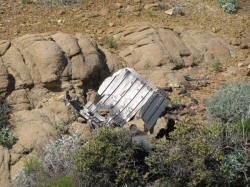|
|
 |
| A Douglas A4 Skyhawk refuels a Vought F8 Crusader. |
Midair collision near Chiriaco Summit, California, between an F8E Crusader & A4C Skyhawk, October 7, 1966
Summary: The two aircraft involved in the accident were part of a final training hop that day of an Air Wing weapons deployment at MCAS Yuma that consisted of 24 aircraft. The strike force consisted of A4 fighters, F8 bombers, F8 fighter escorts, RF8 photo reconnaissance and two, A3 Skywarrior refueling tankers. The strike was conceived to resemble as nearly as possible an actual combat strike in SE Asia. LCDR Paul Barrish was pilot of A4C BuNo 148308, and LTJG Robert Gordon piloted F8E BuNo 150676. All men reported for a briefing at 7:30 am to review weather, line-up, relative positions of the strike element, succession to lead, launch order, navigation, offensive and defensive tactics, communications and emergency procedures. The strike force commenced takeoff from Yuma at 10:15 am with 60 second intervals between sections of aircraft. Once the strike force approached the target area the group received two simulated surface-to-air missile warnings. The first one was determined to not be a threat, however the second one was determined to require evasive action. The flight leader called 'right break', to which the flight element was to commence a high "G" descending right turn for 90 degrees before returning to their planned flight direction. The flight of F8's was approximately 700' behind the A4s, and when they performed this maneuver, Lt. Gordon began to 'slide' to the inside, towards the formation of A4s. Once the A4s completed their turn, they banked left to get back on their original flight path. It was then that the A4 and F8 impacted and fell to the desert floor. The starboard wing of the A4 contacted the starboard side of the F8 cockpit. LCDR Barrish ejected, and unfortunately, Lt. Gordon was killed in the collision. After later debriefing everyone, it was obvious to the Airwing Commander that the tight formation was not workable for more than a division of aircraft. In a tight formation, the pilot's focus is flying on his leader, limiting his ability to look out for other aircraft. The F8 can turn tighter than a bomb-laden A4 and during the high "G" turn of a SAM break, the F8's go from outside the turn to the inside, passing through the A4's formation. After this accident, the tight turn formation was dropped by the airwing. In 2017 I had a phone call with Paul Barrish. He ended up serving 3 tours of duty on the U.S.S. Midway aircraft carrier (now a museum in San Diego), where his 'office' was Ready Room #5. He summed up the accident with these words: "It was another lesson learned the hard way; a pilot killed, two aircraft lost, and Ho Chi Minh didn't fire a single shot!" |
The A4 Skyhawk site (click on the photo to enlarge)
 |
 |
 |
| A view of the Pratt & Whitney J52-P-6A turbojet engine taken at 25 feet above from my drone. | Close-up of the engine. | Another view of the engine. |
 |
 |
 |
 |
| Debris | 20 MM ammo chute and debris. |
 |
 |
 |
 |
| Burn area | Part number confirms this is the A4 crash. | Colors from the national insignia. |
 |
 |
 |
 |
| Instrument dial face. | Data plates. |
 |
 |
 |
 |
| Turbine wheel | Steel belts from the tires. |
 |
 |
 |
The F8 Crusader site
 |
 |
 |
|
| Impact area of the F8 | Wing pylon | Debris |
 |
 |
 |
| Part of the engine tail pipe. |
 |
 |
 |
 |
| Engine | Chance-Vought part stamp |
 |
 |
 |
 |
 |
 |
 |
| The CV heat stamp |